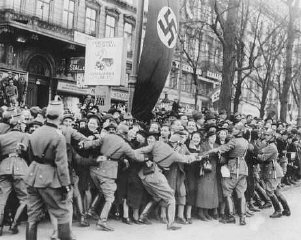|
|

|

|
Cheering crowds greet Hitler as he enters Vienna. Austria, March 1938. See more photographs |
AUSTRIA |
||||
|
|
Before World War II, Jews played an important role in Austria's economic and cultural life. In 1938, Austria had a Jewish population of about 192,000, representing almost 4 percent of the total population. The overwhelming majority of Austrian Jews lived in Vienna, the capital, an important center of Jewish culture, Zionism, and education. Jews comprised about 9 percent of the city's population. However, by December 1939 their number had been reduced to just 57,000, primarily due to emigration. ANSCHLUSS |
THE CAMP SYSTEM IN AUSTRIA During the war, forced labor using concentration camp prisoners became increasingly important to German armaments production. In the summer and fall of 1944, subcamps under the administration of Mauthausen were established near armaments factories throughout northern Austria. The staff at Mauthausen administered more than 60 subcamps, including Gusen, Gunskirchen, Melk, Ebensee, and Amstetten. Thousands of prisoners were worked to death. |
 |
|
||||
|
See more artifacts Desecrated Torah scrolls |
|
In addition to Mauthausen and its subcamps, other camps in Austria extended from Lochau in the west to Strasshof in the east. |
|
KRISTALLNACHT IN AUSTRIA DEPORTATIONS FROM AUSTRIA Systematic mass deportations from Vienna, as elsewhere in Greater Germany, began in October 1941. The Nazis established centers where Jews were to be assembled before deportation. About 35,000 Jews were deported from Vienna to ghettos in eastern Europe, mostly to Minsk, Riga, and Lodz, and to ghettos in the Lublin region of Poland. Most Jews sent to Minsk and Riga were shot by detachments of the Einsatzgruppen (mobile killing units) shortly after arrival. Over 15,000 Viennese Jews were deported to Theresienstadt. Thousands of Jews were also sent to concentration camps in Germany. By November 1942 only about 7,000 Jews remained in Austria, mostly those married to non-Jews. Some Jews remained in hiding. Soviet and American forces occupied Austria in April and May 1945. |
|
|
|
|